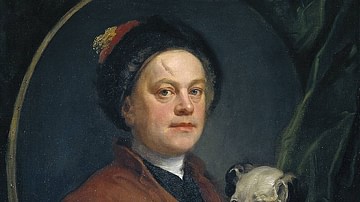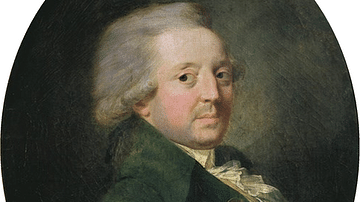
Marie Jean Antoine Nicolas de Caritat, Marquis de Condorcet (1743-1794), also known as Nicolas de Condorcet, was a French philosopher, political theorist, and mathematician. His ideas, encompassing a wide range of topics from education to equal rights, from representative government to the idea of human progress, were said to embody the Age of Enlightenment.
Beginning his career in the field of mathematics, Condorcet quickly became a respected intellectual, rubbing shoulders with the likes of Thomas Jefferson, Leonhard Euler, and Voltaire. He was a proponent of education reform and an early advocate for women's rights and the abolition of colonial slavery. His contributions to political science include the Condorcet method of voting and the Condorcet jury theorem. His most famous work, Sketch for a Historical Picture of the Progress of the Human Spirit paints an optimistic picture of humanity on the path to a perfectly just civilization.
Condorcet played a major role in the French Revolution (1789-99), as a supporter of republican government. After he refused to support the Jacobin constitution in 1793, a warrant went out for his arrest; he was arrested after five months in hiding and died in prison two days later. One of the last great Enlightenment philosophers, Condorcet has been referred to as the "last witness" of the Enlightenment.
Early Life & Mathematic Career
Condorcet was born on 17 September 1743, in the town of Ribemont-sur-Aisne in Picardy. His father, the Chevalier Antoine de Condorcet, was a cavalry captain who, while garrisoned in Ribemont, had met and married the widowed Marie-Madeleine de Gaudry in 1740. Only weeks after the birth of their only child, Antoine de Condorcet was killed on a military exercise at Neuf-Brisach. Widowed for a second time, Nicolas' devoutly pious mother turned to religion to suppress her sorrow; she dedicated her son to the protection of the Virgin Mary. He was privately tutored by a Jesuit instructor until age 11 when he was sent to be educated at the Jesuit school at Reims. Although he would find early academic success at this school, it was here where he likely developed his aversion to religious control of education. Disturbed by the strict discipline and rigid adherence to Catholic dogma he experienced, he would later remark that "humiliation and opprobrium are the natural state of Christians" (Landes, 2022).
In 1758, he continued his education at the prestigious College de Navarre in Paris. After graduating in 1760, he briefly returned to Ribemont to inform his family that he would not be pursuing a military career but would instead seek a vocation in the sciences. After overcoming their objections, he returned to Paris in 1762, where he worked on a formal essay on the topic of integral calculus, which he submitted to the Royal Academy of Sciences. Although the work showed promise, it was rejected for being too sloppy and lacking clarity. Not one for giving up, Condorcet submitted another paper on the same topic to the Academy in February 1764. This second paper was met with adulation, referred to by the judges as elegant and profound. It was published in the annual Histoire de l'Academie des sciences in 1765 and earned Condorcet the attention of renowned mathematician Jean le Rond d'Alembert (1717-83), who took him on as a protégé. This newfound success even led one respected scientist to rank Condorcet among the top ten leading mathematicians in Europe; Condorcet was only 21.
His essay on integral calculus was followed in 1766 by a study of the three-body problem in physics, and, in 1768, with an essay on the application of integral calculus to Newtonian physics. In 1769, he was inducted into the Royal Academy of Sciences and became their permanent secretary in 1777. Around this time, Condorcet started to attend the salon of Julie de Lespinasse (1732-1776), which was a favorite meeting place for many great scientists and philosophers. Here, he would meet famous mathematicians Leonhard Euler (1707-1783) and Daniel Bernoulli (1700-1782) and would even be introduced to Voltaire in 1770. In Lespinasse's salon, Condorcet earned a reputation of being introverted and almost painfully shy, yet possessing of a quick temper; for this reason, Lespinasse referred to him as "a volcano covered in snow" (Landes, 2022). Yet, the salon holder also noted that Condorcet was a fascinating man with a wide knowledge on a variety of topics. Lespinasse said:
... converse with him, read what he has written ... and when you have heard him, you will tell yourself a hundred times a day that this is the most astonishing man you have heard ... Nothing is beneath his attention, and his memory is so prodigious that he has never forgotten anything. (Baker, 1974, xii)
Politics & the Condorcet Method
In Lespinasse's salon, Condorcet befriended French economist Anne-Robert Jacques Turgot (1727-1781), who would become the marquis' political mentor. Turgot, a proponent of the Enlightenment who believed in physiocratic economic theories, would help Condorcet come to the belief that an administration's purpose was to serve the common good above all else. In 1774, Turgot was named Controller-General of Finance by Louis XVI of France (r. 1774-1792). Condorcet defended Turgot's controversial policies such as free trade in grain, the abolition of guilds, and the suppression of the forced labor system known as the corvée. For his friendship and support, Turgot appointed Condorcet inspector-general of the Paris mint.
Turgot's policies made him influential enemies, and he was dismissed from his office in 1776; he died five years later. Condorcet never forgot his mentor's fall. In protest, Condorcet attempted to resign his position as inspector-general, though his resignation was denied. Still, Condorcet continued defending Turgot's policies, celebrating his contributions to free trade in his 1786 work The Life of Turgot.
This experience shifted Condorcet's intellectual focus more towards politics and philosophy. Yet, he was still a scientist at heart and looked at politics through the lens of mathematics. This is exemplified in his 1785 Essay on the Application of Analysis to the Property of Majority Decisions, one of his most significant works. In it, Condorcet uses the doctrine of probabilities to approach social and political affairs, arguing that such a use could subject human life to "mathematical rule", thus giving political science the same precision and certainty as the physical sciences (Furet, 205). Condorcet believed that politics was not so much a matter of will but of reason and collective decisions should not reflect the arbitrary beliefs of individuals but instead the voters' judgment of the truth of the propositions set before them.
Therefore, a majority vote would be justified if the proposition declared to be "true" by the greater number of voters was more likely to be "true" than the lesser number. This idea, known as Condorcet’s jury theorem, is still well-known within the discipline of political science, along with the Condorcet method, a voting method which pairs each candidate in an election head-to-head with every other candidate; as the head-to-head elections are done separately, this should yield a candidate who is clearly preferred by voters, formally called a "Condorcet winner". However, some results may not provide a Condorcet winner, since voter preferences could become cyclical, a problem that has become known as the Condorcet paradox.
While not yet a republican, Condorcet's 1785 essay demonstrates that he had been musing on the idea of representation before the French Revolution. His trust in such a system came from his rejection of the idea that humans are motivated primarily by self-interest and in his belief that love and sympathy are a larger factor in motivation.
Ideas on Feminism, Education, & Slavery
Condorcet's work became increasingly concerned with creating an egalitarian society. Having become one of the most renowned Enlightenment philosophers of his day, his work was widely read, making it all the more significant that his views were extremely progressive for his time, particularly in regard to women's rights. He began writing extensively on the issue after the outbreak of the French Revolution; as the revolutionaries began working to create a new society based on equality and representation, Condorcet rightly feared that the rights of women would be overlooked.
In 1790, he published On the Admission of Women to the Rights of Citizenship, in which he advocated for expanding the social and political rights of women. His reasoning for this was simple; the definition of natural rights, as followed by the Enlightenment and the Revolution, was that they were naturally imbued within man by virtue of his being a sentient creature capable of reason and morality. Why, then, should women be excluded, since they were also sentient beings capable of reason and morality? From this position, Condorcet concluded:
Either no member of the human race has any rights, or they all have the same ones; and anyone who votes against the rights of another, whatever his religion, color, or sex, automatically forfeits his own. (Lukes, 157)
In 1792, after the First French Republic granted universal suffrage to males while excluding women, Condorcet boldly accused the new nation of tyranny for denying half the population their natural rights.
Condorcet's views went against the prevailing theory that men and women were genetically different and women were intellectually inferior by nature. Condorcet knew this to be utter nonsense, claiming that if women were generally more superstitious and less knowledgeable than men, it was only because they were refused the same access to education; the marginalization of women was not the order of nature but constructed by the institutions put in place by men. Striking down the notion that women did not possess the same capacity for reason as men, Condorcet again made the case for women enjoying the same natural, social, and political rights. For this line of thinking, Condorcet is often recognized for his lasting contribution to early feminist thought.
To remedy the idea that women were less educated, Condorcet also took the radical step of proposing girls be educated alongside boys, and have access to all the same occupations upon graduation. Like Jean-Jacques Rousseau, Condorcet believed education to be the emancipation of the individual, and should therefore be secularized and available to all. Along with women's rights and education, Condorcet also became a prominent abolitionist. In 1781, he wrote Reflections on Black Slavery, which helped spark the abolitionist movement in France. In 1788, he joined Jacques-Pierre Brissot's anti-slavery club Société des Amis des Noirs, of which he was elected president in January 1789. He would continue publishing extensively on the issue and later, as a deputy of the Legislative Assembly, would draft bills attacking colonial slavery.
Family & Republicanism
In 1786, at the age of 42, Condorcet married 22-year-old Sophie de Grouchy (1764-1822). The two had met through their common interest in the defense of three peasants who had been victims of legal abuse and who were being represented by Grouchy's uncle. Like Condorcet, Sophie was an intellectual, who had learned English partially so she could translate the works of Adam Smith and Thomas Paine into French. The two bonded over their shared political convictions, their mutual dislike of the Catholic Church, and their optimism about human nature. Shortly after their marriage, Sophie opened a salon at the Hôtel des Monnaies, where Condorcet resided in his position as inspector-general of the mint. Her salon became one of the most famous at the time, hosting such guests as Thomas Jefferson, Cesare Beccaria, Thomas Paine, and playwright Olympe de Gouges. During the Revolution, Sophie's salon became a popular gathering place for members of the Girondin political faction.
When the Revolution began in May 1789, Condorcet greeted it with enthusiasm, welcoming the reconstruction of French society. He took an active role early on, helping his community draw up their cahiers de doléances, or demands for reform that were to be presented before the Estates-General of 1789. He was active in the patriotic Society of 1789, which included such members as Abbé Sieyès, Marquis de Lafayette, and Charles-Maurice de Talleyrand. The Society of 1789, at the time the second most popular political club following the Jacobins, was a haven for liberal elites who agreed with the changes of 1789 but believed by 1791 it was time to bring the Revolution to an end, with France as a constitutional monarchy.
Yet Condorcet's opinions would quickly shift away from constitutional monarchism because of the events of 1791. The king's flight to Varennes on 20-21 June disturbed Condorcet, who believed Louis XVI's escape attempt meant that he could not be trusted. Further, Condorcet became convinced that the presence of a king in France would only encourage disorder. His budding republican views would be confirmed a month later when the Paris National Guard opened fire on a group of republican demonstrators in the Champ de Mars Massacre, an incident made more personal to Condorcet since his wife and one-year-old daughter Eliza had been in the crowd that day. After the massacre, Condorcet and his wife Sophie teamed up with Thomas Paine and Brissot to publish a journal titled Le Republicain, with the goal being to promote republicanism and reject constitutional monarchy. In the journal, they argued that monarchy in any form was a threat to liberty.
Revolutionary Career & Death
In September 1791, Condorcet won election to the Legislative Assembly, representing Paris. He was made the Assembly's secretary and tasked with reforming the French educational system. Harkening back to the influence of Turgot and the physiocrats, Condorcet's education plan was to focus on the individual learner rather than the communal and center around Enlightenment thought. Presented to the Assembly in April 1792, this plan would form the basis of that which was eventually adopted.
Aligning himself with Brissot, Condorcet became one of the leading voices in the Assembly calling for a republic. In early 1792, he joined the Brissotins in pressing for war with Austria, believing war to be the only means of extinguishing the foreign threat. Once war had been achieved, he drew up the declaration that justified the suspension of the king in August and summoned the National Convention. In September 1792, the First French Republic was officially declared, and three months later, Louis XVI was put on trial for treason. Although he supported the trial itself, Condorcet was principally opposed to capital punishment and was one of the 319 Convention deputies to vote for the king's imprisonment and banishment as an alternative to execution. Of course, the vote for the death penalty carried, and the former king was executed on 21 January 1793.
After Louis XVI's death, tensions began to grow between the Jacobins and the (comparatively) moderate Girondin faction, led by Brissot. Although not a Girondin himself, Condorcet found himself linked to the faction when he was placed on the Constitution Committee to draft a constitution for the new republic. He became the main author of what would become known as the Girondin constitution, which would never be put to a vote. After the radical Montagnards won control of the Convention, they put forth their own Jacobin constitution, which would become the Constitution of Year I. Enraged, Condorcet defended his own work and attacked the new constitution, earning him the wrath of the dominant Montagnards. On 3 October, the same day many prominent Girondins were rounded up, a warrant went out for Condorcet's arrest, forcing him to go into hiding.
For five months, Condorcet hid in the home of a friend. While there, he wrote Sketch for a Historical Picture of the Progress of the Human Spirit. Published posthumously in 1795, it is considered one of the most significant Enlightenment texts. Perhaps an attempt by Condorcet to console himself during the despair of the Reign of Terror, his Sketch asserts that humanity's expanding knowledge of the natural and social sciences would lead to a just world of individual freedom, and moral compassion. He represents humans as starting with no superiority over other animals, except for bodily organization. From these savage beginnings, humankind has advanced on the path of enlightenment and virtue through nine great epochs of history. The tenth epoch, still in the future, can only be achieved through the destruction of inequality between nations, the destruction of inequality between classes, and the perfectibility of human nature itself, intellectually, morally, and physically. Condorcet's Sketch is also notable for its aversion to religion and monarchy and for positing that social evils are the result of ignorance (Baker, On Condorcet's Sketch).
After months of hiding, Condorcet's paranoia got the better of him. He believed he was being watched, and so, in March 1794, he escaped his hideout. For three days he hid in thickets and slept in roadside ditches until he came to the village of Clamart, where he was recognized and arrested. He was imprisoned in Bourg-la-Reine, where he was found dead after two days, on 29 March, aged 50. The manner of his death remains unknown; the most widely accepted theory is that he drank poison to avoid the indignity of a public execution. However, some historians believe that he may have been murdered, or that he expired from exhaustion after his three days on the run. Condorcet was survived by his wife Sophie, who published his unfinished works and lived until 1822, and his daughter Eliza, who would marry the exiled Irish revolutionary Arthur O'Connor in 1807. Although Condorcet's remains were lost in the 19th century, he was given a symbolic burial in the French Panthéon in 1989.










